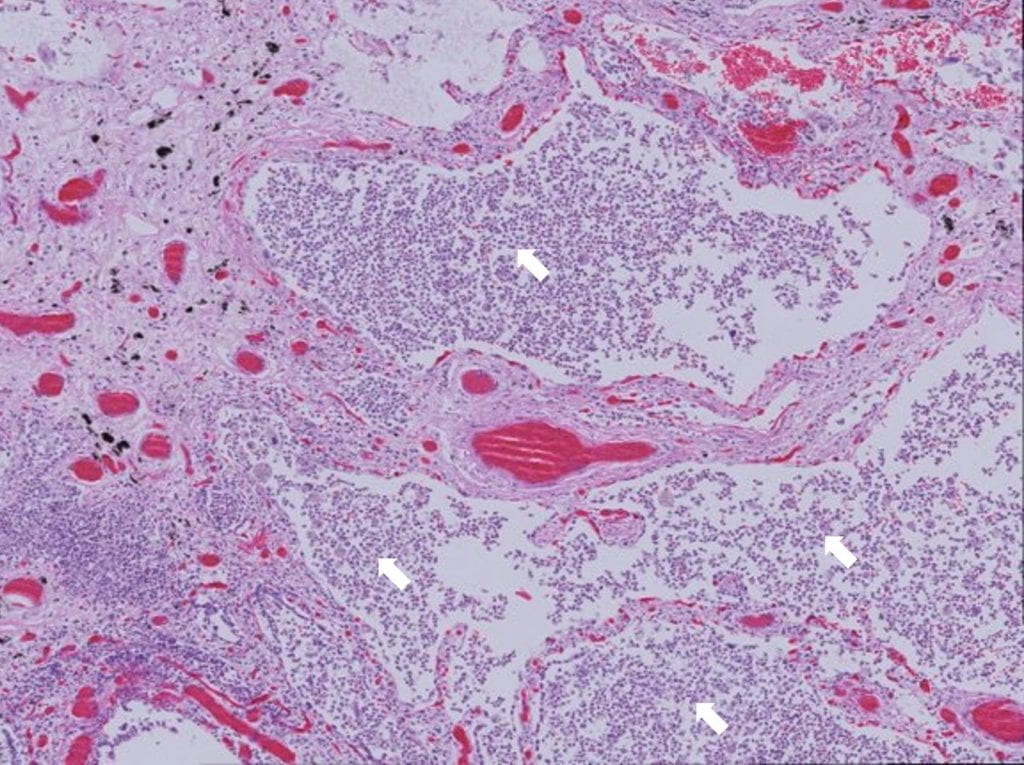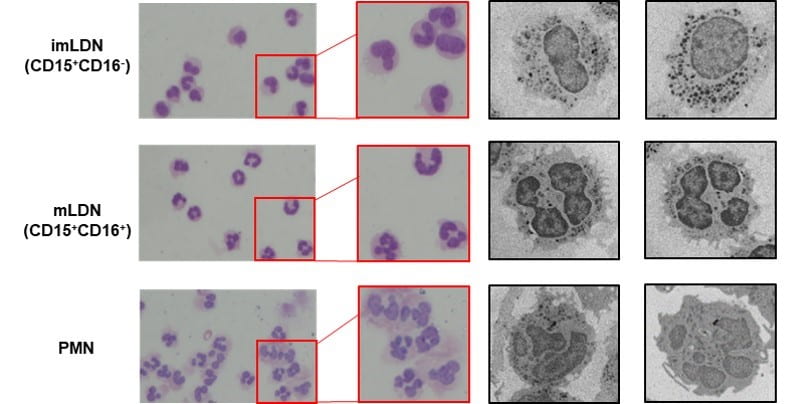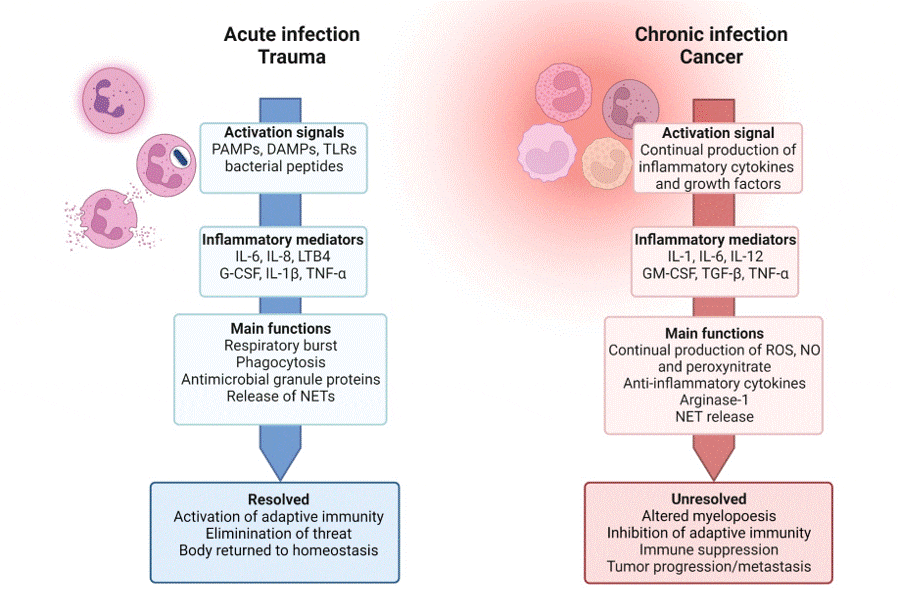Dysregulation of neutrophil immune regulatory activity as a driving mechanism of pathogenesis in HIV-1-infection.

Neutrophils, the most abundant nucleated immune cell population in the body, play an important role in the regulation of adaptive and innate immune systems. We have shown that neutrophils from HIV-1-infected individuals display an activated phenotype, specific transcriptional profile, and increased rate of degranulation.
HIV-1 infection is associated with altered myeloid cell homeostasis resulting in changes in the population frequency and functional activity of diverse granulocytic populations. Dysregulation of granulocytic recruitment, function, and clearance contributes to the pathogenesis of cardiovascular and liver diseases associated with HIV-1 infection.
Neutrophils in the blood of HIV-1-infected individuals express high levels of PD-L1 that is induced by HIV-1 virions and products of microbial translocation, including lipopolysaccharide (LPS). Neutrophil PD-L1 levels correlate with the expression of PD-1 on CD4+ and CD8+ T cells, elevated levels of neutrophil degranulation markers in plasma, and increased frequency of low-density neutrophils expressing the phenotype of granulocytic myeloid-derived suppressor cells (G-MDSCs). Neutrophils purified from the blood of HIV-1-infected patients suppress T cell function via several mechanisms, including PD-L1/PD-1 interaction and production of reactive oxygen species (ROS). The accumulated data suggest that chronic HIV-1 infection results in an induction of the immunosuppressive activity of neutrophils characterized by high expression of PD-L1 and an inhibitory effect on T cell function. This newly identified mechanism of immune suppression mediated by neutrophils may alter our understanding of HIV-1 pathogenesis. Furthermore, we have shown that neutrophils from HIV-1-infected individuals display a high capacity to undergo NETosis. Production of neutrophil extracellular traps (NETs) likely contributes to an increased risk of cardiovascular and liver diseases in HIV-1-infected individuals.

- Hel, Z., McGhee, J., Mestecky, J. 2006. HIV infection: First battle decides the war. Trends Immunol. 27: 274-281. https://pubmed.ncbi.nlm.nih.gov/16679064/
- Bowers, N., Helton, S., Huijbregts, R.P.H., Goepfert, P., Heath, S., and Z. Hel. 2014. Immune Suppression by Neutrophils in HIV-1 Infection: Role of PD-L1/PD-1 Pathway. PLOS Pathogens. 10 :e1003993. F1000 Prime recommended. https://pubmed.ncbi.nlm.nih.gov/24626392/
- Hel, Z., Xu, J., Denning. W., Helton, S., Heath, S. L., Christmann, B.S., Elson, C.O., Goepfert, P., and Mestecky, J. 2017. Dysregulation of systemic and mucosal humoral responses to microbial and food antigens as a factor contributing to microbial translocation and chronic inflammation in HIV-1 infection. PLOS Pathogens. 13:e1006087. (Selected as a Featured article by PLOS Pathogens, selected for Press Release and posting to AAAS EurekAlert Science News). https://pubmed.ncbi.nlm.nih.gov/28125732/
- Connelly, A.N., Huijbregts, R.P.H., Pal, H.C., Kuznetsova, V., Davis. M.D., Ong, K.L., Fay, C.X., Greene, M.E., Overton, E.E., and Z. Hel. 2022. Optimization of methods for the accurate characterization of whole blood neutrophils. Scientific Reports. 12:3667. https://pubmed.ncbi.nlm.nih.gov/35256648/
Neutrophils and cancer.

Our research focuses on neutrophils and granulocytic myeloid-derived suppressor cells (G-MDSCs), cell populations that have been recently identified to play a critical role in the regulation of adaptive and innate immune responses in cancer and chronic inflammatory conditions.
Hematologic malignancies, including multiple myeloma (MM), promote systemic immune dysregulation resulting in an alteration and increased plasticity of myeloid cell subsets. To establish the predictive roles of specific myeloid cell subsets, we performed a detailed investigation of the phenotype and function of neutrophils, monocytes, and eosinophils in the peripheral blood of patients with MM. Two distinct phenotypes of the myeloid cell compartment were identified referred to as MM1 and MM2. Compared to healthy controls or MM1 patients, neutrophils from MM2 patients exhibited a less differentiated phenotype characterized by elevated surface levels of CD64 (FcgRI) and decreased levels of CD10 and CXC chemokine receptor 2 (CXCR2) and exerted higher capacity for the production of mitochondrial reactive oxygen species. In addition, a significant expansion of an immature CD15+CD16– neutrophil subpopulation was observed in the circulation of MM2 patients. Classical and patrolling monocyte subsets from MM2 patients were characterized by elevated CD64 expression, with patrolling monocytes displaying phenotypic features consistent with immune suppression. Characteristic features of the MM2 phenotype were associated with myeloma-defining events, including elevated serum calcium, decreased hemoglobin, and elevated involved / uninvolved immunoglobulin free light chain (FLC) ratio at diagnosis. Detailed characterization of an altered myeloid phenotype indicative of dysregulated myelopoiesis is likely to improve our understanding of the mechanisms of disease progression in patients with MM.

The impact of hormonal contraceptives on HIV-1 acquisition and transmission.
Safe and effective methods of contraception represent a critical component of preventive health care reducing maternal and infant mortality, especially in women living in resource-limited settings. Depot medroxyprogesterone acetate (DMPA; Depo-Provera) is a highly effective progestin-based contraceptive and one of the most commonly used contraceptives in sub-Saharan Africa. Several epidemiological studies indicate an association between the use of DMPA and an increased risk of HIV-1 infection. Modeling studies indicate that the use of injectable contraceptives may be responsible for hundreds of thousands of new HIV-1 transmissions annually. It is therefore critically important to identify safe forms of contraception without a significant deleterious effect on the systemic and mucosal immune environment. We demonstrated that medroxyprogesterone acetate (MPA) suppresses the antigen-immune function of T cells and dendritic cells via direct and indirect mechanisms and increases the rate of HIV-1 proliferation.

In a clinical study performed at UAB, we analyzed vaginal biopsies and various immune parameters in the blood of women using various forms of hormonal contraceptives. We showed that the use of MPA is associated with thinning of the vaginal epithelial wall and decreased production of IFN-α by plasmacytoid dendritic cells. We have shown that MPA reduces the defense mechanisms of genital epithelium by suppressing factors critical for the barrier function and structural integrity of the vaginal and cervical epithelium. Decreased production of these factors reduces the resistance of genital epithelial tissue to microabrasions and increases the probability of HIV-1 transcytosis and transmigration, leading to exposure of target cells in the parabasal epithelium and lamina propria. Furthermore, DMPA and NuvaRing (etonogestrel) significantly suppress the cervicovaginal levels of principal anti-HIV-1 inhibitory factors human β-defensin 2 and 3 and secretory leukocyte protease inhibitor (SLPI). In a recent randomized clinical study in Lusaka, Zambia, we showed that administration of MPA decreases the production of several factors in the cervicovaginal fluid of HIV-1-infected women that may contribute to higher shedding of the virus and potentially to increased rates of viral transmission. In search of safe contraceptives, we have demonstrated that norethisterone (NET) and levonorgestrel (LNG) do not inhibit the function of dendritic cells and T cells and therefore represent a safe and effective alternative to DMPA.
- Hel, Z., Stringer, E., and J. Mestecky. 2010. Sex steroid hormones, hormonal contraception, and the immunobiology of HIV-1 infection. Endocr. Rev. 31:79-97. https://pubmed.ncbi.nlm.nih.gov/19903932/
- Huijbregts, R., Helton, S., Michel, K., Richter, H., Goepfert, P., and Z. Hel. 2013. Hormonal contraception and HIV-1 infection: Medroxyprogesterone acetate suppresses innate and adaptive immune mechanisms. Endocrinology. 154:1282-1295. Associated editorial: Hapgood, J., Immunosuppressive biological mechanisms support reassessment of use of the injectable contraceptive medroxyprogesterone acetate. Endocrinology 2013;154:985. Comments published in: Wilson, C., Reproductive Endocrinology: DMPA suppresses response to HIV-1. Nat. Rev. Endocrinol. 2013; 9:187. https://pubmed.ncbi.nlm.nih.gov/23354099/
- Huijbregts, R.P.H., Michel, G., and Z. Hel. 2014. Effect of progestins on immunity: medroxyprogesterone but not norethisterone or levonorgestrel suppresses the function of T cells and pDCs. Contraception. 90:123-129. https://pubmed.ncbi.nlm.nih.gov/24674041/
- Michel, K.G., Huijbregts, R.P.H., Gleason, J.L., Richter, H., E., and Z. Hel. 2015. Effect of hormonal contraception on the function of plasmacytoid dendritic cells and distribution of immune cell populations in the female reproductive tract. JAIDS. 68:511-518. https://pubmed.ncbi.nlm.nih.gov/25763784/
- Hapgood, J.P., Kaushic, C., and Z. Hel. 2018. Hormonal Contraception and HIV-1 Acquisition: Biological Mechanisms. Endocrine Reviews. 39:36-78. Selected for Press Release by Endocrine Reviews and for posting to AAAS EurekAlert Science News. https://pubmed.ncbi.nlm.nih.gov/29309550/
Design and Testing of HIV-1 Vaccine Candidates.
With a team of collaborators, we showed that: 1) Antiretroviral treatment (ART) initiated in the acute phase of HIV infection results in a functional cure and control of viremia in absence of ART; 2) Therapeutic immunization against HIV and possibly other chronic viral infections is feasible and effective; and 3) Peptide-based vaccine delivered on the mucosal surface protects against HIV. These breakthrough paradigm shift publications have initiated a series of clinical trials in humans and changes in the treatment of HIV-1 infected individuals. Furthermore, we demonstrated that a vaccine based on the induction of cytotoxic (CD8+) and helper (CD4+) T cells protects against HIV infection in an animal model; this has significantly contributed to HIV vaccine development. We have also demonstrated the prevention of infection by intravaginal application of agents enhancing the protective properties of the genital mucosa.
- Hel, Z., Venzon,D., Poudyal, M., Tsai, W.P., Giuliani, L., Woodward, R., Chougnet, C., Shearer, G., Altman, J., Watkins,D., Bischofberger, N., Abimuku, A., Markham, P., Tattaglia, J., and Franchini, G. 2000. Viremia control following structured treatment interruption and therapeutic immunization of SIV251 -infected macaques. Nature Med. 6:1140-6. https://pubmed.ncbi.nlm.nih.gov/11017146/
- Belyakov, I.M., Hel, Z., Kelsall, B., Kuznetsov, V.A., Ahlers, J.D., Nacsa, J., Watkins, D.I., Allen, T.M., Sette, A., Altman, J., Woodward, R., Markham, P.D., Clements, J.D., Franchini, G., Strober, W., and J. A. Berzofsky. 2001. Mucosal AIDS vaccine reduces disease and viral load in gut reservoir and blood after mucosal infection of macaques. Nature Med. 7:1320-6. https://pubmed.ncbi.nlm.nih.gov/11726972/
- Hel, Z., Tsai, W.P., Thornton, A., Nacsa, J., Giuliani, L., Tryniszewska, E., Poudyal, M., Venzon, D., Wang, X., Altman, J., Watkins, D.I., Lu, W., von Gegerfelt, A., Felber, B.K., Tartaglia, J., Pavlakis, G.N., and G. Franchini. 2001. Potentiation of Simian immunodeficiency virus (SIV)-specific CD4(+) and CD8(+) T cell responses by a DNA-SIV and NYVAC-SIV prime/boost regimen. J. Immunol. 167: 7180-7191. https://pubmed.ncbi.nlm.nih.gov/11739541/
- Hel, Z., Johnson, J.M., Tryniszewska, E., Tsai, W.P., Harrod, R., Fullen, J., Tartaglia, J., and G. Franchini. 2002. A novel chimeric Rev, Tat, and Nef (Retanef) antigen as a component of an SIV/HIV vaccine. Vaccine 20:3171-3186. https://pubmed.ncbi.nlm.nih.gov/12163269/
- Hel, Z., Nacsa,J., Tryniszewska, E., Tsai, W.P., Washington-Parks, R., Montefiori, D.C., Felber, B.K., Pavlakis, G.N., Tartaglia, J., and G. Franchini. 2002. Containment of SIV infection in vaccinated macaques: Correlation with the magnitude of virus-specific pre- and post-challenge CD4+ and CD8+ T-cell responses. J. Immunol. 169:4778-4787. https://pubmed.ncbi.nlm.nih.gov/12391187/
- Hel, Z., Tsai, W.-P., Tryniszewska, E., Nacsa, J., Markham, P.D., Lewis, M.G., Pavlakis, G.N., Felber, B.K., Tartaglia, J., and Franchini, G. 2006. Improved vaccine protection from simian AIDS by the addition of nonstructural SIV genes. J. Immunol. 176:85-96. https://pubmed.ncbi.nlm.nih.gov/16365399/
Immunodeficiency diseases: Common Variable Immunodeficiency Disorders (CVID).
CVID, the most frequent symptomatic humoral primary immunodeficiency, is associated with chronic T cell activation and reduced frequency of CD4+ T cells, and thus it resembles HIV-1 infection. The underlying cause of immune activation in CVID is unknown. We found that in CVID subjects the concentration of plasma sCD14 is significantly increased and correlates with the level of sCD25, C-reactive protein, and the extent of T cell activation. Furthermore, elevated plasma sCD14 is associated with decreased frequencies of CD4+ T, NK, and B cells. The obtained data suggest that chronic T cell activation in CVID is associated with elevated levels of sCD14 and sCD25 but not with the signs of microbial translocation.

The specific mechanisms mediating immune deficiency in CVID remain to be determined. We showed that neutrophils from CVID patients exhibited elevated surface levels of specific markers that are consistent with a phenotype of activated neutrophils with suppressive properties. CVID neutrophils actively suppressed T cell activation and production of IFN-γ via ROS function.
CVID was associated with an increased frequency of low-density neutrophils (LDNs)/granulocytic myeloid-derived suppressor cells (G-MDSCs). LDN/G-MDSC frequency in CVID patients correlated with reduced T cell responsiveness. These data demonstrate that neutrophils in the blood of CVID patients acquire an activated phenotype and exert potent T cell suppressive activity. Specific targeting of myeloid cell-derived suppressor activity represents a novel potential therapeutic strategy for CVID.
- Litzman, J., Nechvatalova, J., Xu, J., Ticha, O., Vlkova, M., and Z. Hel. 2012. Chronic immune activation in common variable immunodeficiency (CVID) is associated with elevated plasma levels of soluble CD14 and CD25 but not endotoxemia. Clin. Exp. Immunol. 170:321-332. https://pubmed.ncbi.nlm.nih.gov/23121673/
- Vlkova M., Chovancova, Z., Nechvatalova J., Connely, A.N., Davis, M.D., Slanina, P. Travnickova L. Litzman M., Freiberger T., Litzman J., and Z. Hel. 2019. Neutrophil and granulocytic myeloid-derived suppressor cell (G-MDSC)-mediated immune suppression in common variable immunodeficiency disorders (CVID). J. Immunol. 202: 93-104. https://pubmed.ncbi.nlm.nih.gov/30487174/
